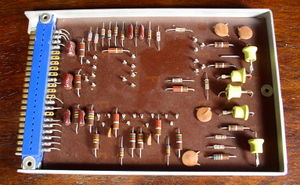Difference between revisions of "PDP-6"
m (add pic) |
m (+cat) |
||
| (7 intermediate revisions by 2 users not shown) | |||
| Line 6: | Line 6: | ||
| year first shipped = June, 1964 | | year first shipped = June, 1964 | ||
| year discontinued = 1965 | | year discontinued = 1965 | ||
| − | | form factor = [[mainframe]] | + | | form factor = small [[mainframe]] |
| word size = 36 bits | | word size = 36 bits | ||
| physical address = 18 bits | | physical address = 18 bits | ||
| Line 15: | Line 15: | ||
| memory speed = 5 μsec (inital), 2 μsec (later) | | memory speed = 5 μsec (inital), 2 μsec (later) | ||
| memory mgmt = single base and bounds register pair | | memory mgmt = single base and bounds register pair | ||
| − | | operating system = Monitor, [[ITS]] | + | | operating system = Monitor, [[ITS]], [[WAITS]] |
| predecessor = None | | predecessor = None | ||
| successor = [[KA10]] | | successor = [[KA10]] | ||
| Line 26: | Line 26: | ||
The machine was not a success, commercially (only 23 were sold), in part because the hardware was unreliable (largely because of one type of large System Module, which contained one bit of the entire [[ALU]] section of the [[CPU]] - a 'bridge too far' at the then-current state of [[printed circuit board]] technology). | The machine was not a success, commercially (only 23 were sold), in part because the hardware was unreliable (largely because of one type of large System Module, which contained one bit of the entire [[ALU]] section of the [[CPU]] - a 'bridge too far' at the then-current state of [[printed circuit board]] technology). | ||
| + | |||
| + | According to Tim Anderson, the Project MAC group Dynamic Modeling/Computer Graphics took delivery of the very last PDP-6 from a previous owner. They adopted the AI Lab's [[Incompatible Timesharing System|ITS]] [[operating system]], but shortly after moved onto a [[PDP-10]]. | ||
==External links== | ==External links== | ||
| Line 32: | Line 34: | ||
* [http://www.decodesystems.com/pdp6.html The DEC PDP-6 Time-Sharing Computer] | * [http://www.decodesystems.com/pdp6.html The DEC PDP-6 Time-Sharing Computer] | ||
* [http://www.ultimate.com/phil/pdp10/pdp6-serials.html DEC PDP-6 Serial numbers] | * [http://www.ultimate.com/phil/pdp10/pdp6-serials.html DEC PDP-6 Serial numbers] | ||
| + | * [http://bitsavers.org/pdf/dec/pdp6 Bitsavers] | ||
| + | * [https://github.com/aap/pdp6 Simulator based on processor schematics] | ||
| + | |||
| + | {{semi-stub}} | ||
| − | + | [[Category: DEC Systems]] | |
Revision as of 01:40, 20 December 2018
| PDP-6 | |
| Manufacturer: | Digital Equipment Corporation |
|---|---|
| Architecture: | PDP-10 |
| Year Design Started: | March, 1963 |
| Year First Shipped: | June, 1964 |
| Year Discontinued: | 1965 |
| Form Factor: | small mainframe |
| Word Size: | 36 bits |
| Logic Type: | germanium and silicon transistors |
| Design Type: | asynchronous with hardware subroutines |
| Clock Speed: | 4 μsec (approximately - different instructions take different amounts of time, the CPU is not synchronous) |
| Memory Speed: | 5 μsec (inital), 2 μsec (later) |
| Physical Address Size: | 18 bits |
| Virtual Address Size: | 18 bits |
| Memory Management: | single base and bounds register pair |
| Operating System: | Monitor, ITS, WAITS |
| Predecessor(s): | None |
| Successor(s): | KA10 |
| Price: | US$120K (CPU), US$300K (system) |
The PDP-6 was effectively the first model of the PDP-10; they are (mostly) binary-code compatible. It was built out of System Modules, DEC's predecessor to the FLIP CHIP module series (out of which the first PDP-10, the KA10, was built).
The machine was not a success, commercially (only 23 were sold), in part because the hardware was unreliable (largely because of one type of large System Module, which contained one bit of the entire ALU section of the CPU - a 'bridge too far' at the then-current state of printed circuit board technology).
According to Tim Anderson, the Project MAC group Dynamic Modeling/Computer Graphics took delivery of the very last PDP-6 from a previous owner. They adopted the AI Lab's ITS operating system, but shortly after moved onto a PDP-10.
